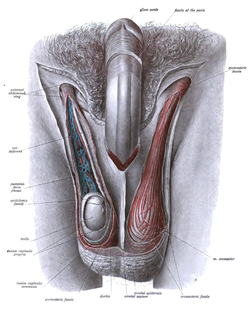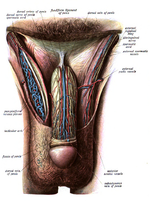User:Creigpat/Male Reproductive System
| Male reproductive system | |
|---|---|
 Dissection of human male external genetalia showing different surrounding structures of the scrotum, such as testis, epidermis etc. | |
| Details | |
| Identifiers | |
| Latin | systema genitale masculinum |
| Anatomical terminology | |
The male reproductive system consists of a number of sex organs that form a part of the human reproductive process. In this type of reproductive system, these sex organs are located outside the body, around the pelvic region.
The main male sex organs are the penis and the testicles which produce semen and sperm, which, as part of sexual intercourse, fertilize an ovum in the female's body; the fertilized ovum (zygote) develops into a fetus, which is later born as a child.
Corresponding equivalent among females is the female reproductive system.
External genital organs
[edit]
Penis
[edit]The penis is the male copulatory organ. It has a long shaft and an enlarged bulbous-shaped tip called the glans penis, which supports and is protected by the foreskin in uncircumcised males. When the male becomes sexually aroused, the penis becomes erect and ready for sexual activity. Erection occurs because sinuses within the erectile tissue of the penis become filled with blood. The arteries of the penis are dilated while the veins are passively compressed so that blood flows into the erectile cartilage under pressure.
Scrotum
[edit]The scrotum is a pouch-like structure that hangs behind the penis. It holds and protects the testes. It also contains numerous nerves and blood vessels. During times of lower temperatures, the Cremaster muscle contracts and pulls the scrotum closer to the body, while the Dartos muscle gives it a wrinkled appearance; when the temperature increases, the Cremaster and Dartos muscles relax to bring down the scrotum away from the body and remove the wrinkles respectively.
The scrotum remains connected with the abdomen or pelvic cavity by the inguinal canal. (The spermatic cord, formed from spermatic artery, vein and nerve bound together with connective tissue passes into the testis through inguinal canal.)
Internal genital organs
[edit]
Epididymis
[edit]The epididymis, a whitish mass of tightly coiled tubes cupped against the testicles, acts as a maturation and storage for sperm before they pass into the vas deferens, that carry sperm to the ampullary gland and prostatic ducts.
Vas deferens
[edit]The vas deferens, also known as the sperm duct, is a thin tube approximately 30 centimetres (0.98 ft) long that starts from the epididymis to the pelvic cavity.
Accessory glands
[edit]Three accessory glands provide fluids that lubricate the duct system and nourish the sperm cells. They are the seminal vesicles, the prostate gland, and the bulbourethral glands (Cowper glands).
Seminal vesicles
[edit]Seminal vesicles are sac-like structures attached to the vas deferens at one side of the bladder. They produce a sticky, yellowish fluid that contain fructose. This fluid provides sperm cells energy and aids in their motility. 70% of the semen is its secretion.
Prostate gland
[edit]The prostate gland surrounds the ejaculatory ducts at the base of the male urethra, just below the bladder. The prostate gland is responsible for the proof semen, a liquid mixture of sperm cells, prostate fluid and seminal fluid. This gland is also responsible for making the semen milky in appearance by mixing calcium to the semen coming from seminal vesicle (semen coming from the seminal vesicle is yellowish in color); the semen remains cloudy and clumpy until the prostatic profibrinolysin is formed into fibrinolysin and lysis of the fibrinogen from the seminal vesicle fluids occurs.
Bulbourethral glands
[edit]The bulbourethral glands, or Cowper’s glands, are pea-sized structures located on the sides of the urethra just below the prostate gland. These glands produce a clear, slippery fluid that empties directly into the urethra. This fluid serves to lubricate the urethra and to neutralize any acidity that may be present due to residual drops of urine in the urethra.
See also
[edit]References
[edit]| Internal |
| ||||||||||
|---|---|---|---|---|---|---|---|---|---|---|---|
| External |
| ||||||||||
Text is available under the CC BY-SA 4.0 license; additional terms may apply.
Images, videos and audio are available under their respective licenses.
